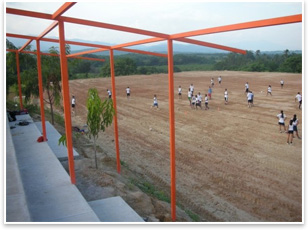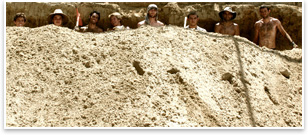Youth-Led Construction Team Builds Developing World Connections with Community Center
Anthony Laney is taking a stand—on his profession and his faith
By Zach Mortice
Associate Editor

Concrete steps above the soccer field Laney and
his team have helped to build.
Summary: As he’s done in previous years, Anthony Laney, Assoc. AIA, a young architect from Los Angeles, is preparing to take a group of high school students to Oaxaca, Mexico, this summer to work on building neighborhood infrastructure projects and mission work with his church. On these trips, he’s noticed that it’s the physical act of making and construction that most intrigues young people about architecture, far from the notion of architects as detached designers.
Images courtesy of Anthony Laney
“These are the things that inspire kids to go into architecture,” he says. “It’s admirable that there’s a guy who at a young age is seeing that with a little more training, we can take this a lot further.”
Eleventh grader Lindsey McPheeters, one student who attends Laney’s church and goes on his trips to Mexico, says this physical ritual of construction is required to take them to a deeper level of commitment in their building outreach work: a spiritual connection with the people they’re working for. “You have to do the physical type of thing in order to get to that spiritual level where you can actually talk to someone about what they believe and get a closer bond,” she says.
As such, it’s Laney’s top priority that the activist outreach trips he leads address deficiencies in the build environment as well as people’s spiritual hunger. “It would be foolish for me to neglect either,” he says. “I can’t proclaim a faith that has no deeds, and I can’t simply devote my life to an architecture that doesn’t actually fill any spiritual needs. We are driven by the privilege of sharing Christ's love, to our friends on both sides of the border.”
Body and spirit
Laney, who graduated with an architecture degree from the University of Southern California in May 2008, has gone on three trips to Oaxaca, first while he was in high school and later as a leader once he graduated from college. After his second trip to Oaxaca in high school, no one else from his church went back, and later talk of restarting the mission trips at his church, Hope Chapel in Hermosa Beach, Calif., pulled him back in. “After going to college and studying architecture, I began to get excited about this collision or integration between my faith and this profession that I’ve been thrown into, which is why I decided to get involved again,” Laney says.
For his third trip to Mexico, Laney placed more of an emphasis on
getting youth involved in this work and helped lead a team of 20
high school and college students. While there, Laney works with the
El Refugio community center in Puerto Escondido, which was established
by former Hope Chapel church members. El Refugio is their link to
the needs of the local community, and through them Laney and his
troupe have repaired school buildings, built additions to the community
center itself, and are currently helping to build a soccer field.
Last year they dug out space for a retaining wall for bleachers so
that concrete could be poured, and they’ll continue this project
this summer on their next trip. These projects focus mostly on unskilled,
manual labor, but Laney has also worked on other more design-oriented,
developing-world outreach projects, like studying emerging economies
and their architectural needs in the Mexican province of Chiapas,
and designing and building a canopy roof structure for a multipurpose
event space in Brazil.
Everyone who goes on the trip is responsible for raising his or her own money (about $1,000 per person), which means bake sales, garage sales, car washes, and soliciting donations. Laney sells his own sketches. The students are rewarded for this hard work with 10 long days of early mornings and intense physical labor. A typical day begins near dawn, with a quick surf or stint in the kitchen to help prepare breakfast. After they eat, the students break into small Bible study groups, and by 9:00 a.m. they are then dispatched into groups for their building project of the day. They work until 3:00 p.m. and come back to El Refugio for dinner and more Bible study or worship services. Sometimes, this takes them out onto the street to perform live action skits that illustrate principles of their ministry. Before they get to bed, they take time for group introspection and reflection on what they’ve experience, felt, and thought of that day.

The retaining wall ditch Laney and his team dug.
They are long days, with Laney leading the charge. “Because he works so hard, the kids respect him,” says Kapena Cavuto, a youth and college minister at Hope Chapel who has co-led Laney’s Oaxaca trips.
“He always has extra stuff for us to do in preparing for it, so it’s not like he takes the whole thing on himself,” says McPheeters, who’s going to Puerto Escondido again this summer. “He actually gets us involved. He’s not just like a boss who bosses us around.”
Through El Refugio, Laney and his team has been addressing the need for youth-centered outreach infrastructure for the local community. The community center often uses soccer as a node of interaction for young people, and they need more multi-purpose spaces, like the soccer field Laney and his team have been working on, to support this. “You could do haircuts, face painting, soccer clinics, classes,” Laney says. “You could do anything.”
“[For] a building project, the best part for me was seeing locals’ reaction and how much they appreciated what we did,” says 10th grader Cote Dorion, who will also go to Oaxaca again this summer.
Work and life
For Laney and a growing number of young practitioners, the most relevant frontier of contemporary practice is social activism—employing design as a tool to improve people’s lives, not as an end or aspiration unto itself. He goes a step further in drawing a parallel between the worldly and divine. “If architecture operates with people, and if you can make the leap of faith and agree that people have souls, you’re never just undertaking a purely humanistic project,” he says. “You’re never operating outside the realm of spiritual impact. I get most excited when I can see my work more clearly reflect an alignment between my spiritual convictions and my profession.”
But that’s not a feeling he gets every minute of every day. Rockefeller Partners Architects, the firm he works for, designs high-end custom homes. And of course he recognizes the disconnect. “I know that I want to be about something bigger,” Laney says. “I also know that I’m in the process of getting my architecture license and paying off student loans, so I consider my job to be a blessing because it’s funding this trip.”
Just as it’s a challenge in his own life, Laney says the biggest challenge he faces with this building outreach work is to get his younger teammates to pursue the same kind of work-life harmony he looks for.
|



